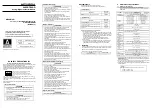
42
Miscellaneous Page
Second Between
Alarm Updates
View or set how frequently the alarm indications will be
refreshed on the Logs page
Web Timeout
View or set the time before a web user is logged off due to
inactivity.
Minutes between
SNMP traps
View or set the frequency with which SNMP traps are resent. A
value of 0 will cause traps to be sent only when an alarm
initially occurs.
Converter Name
View or set the assigned converter name
Enable Firmware
Upgrade
Permit or prevent remote upgrade of the converter firmware.
Enable Telnet
Permit or prevent Telnet access
Enable Test Alarm
Force a false alarm for test purposes
Old Password
New Password
New Password
Update the system password (1-5 digits). All three values must
be entered. If the old password does not match the existing
password, or the two new password entries are different, the
update will not occur.
Logs Page
Alarm Indicators
View any pending system alarms
Log Listing
View a listing of all system log entries
Clear Logs
Clear the system log
Logout Page
(N/A)
The user is logged off the system
Access via SNMP
The Multiband Block Converter may be accessed and monitored via the Simple Network
Management Protocol (SNMP). SNMP is designed for control of network elements from a
central management point.
The SNMP Management Information Base (MIB) file for the system, available from MITEQ
defines the specifics of the interface. This file is read by the chosen SNMP management tool to
provide an “understanding” of the interface. The MIB file is in a format that can be ready with
any text editor. Do NOT modify this file.
SNMP operating parameters may be set on the COMMS web page. If SNMP
operation is not desired, this feature may be rendered inaccessible by inserting a long arbitrary
string in the Read Community and Write Community fields.
Access via Telnet
The Converter may be accessed via Telnet. There is no special protocol on the Telnet channel;
the Converter will expect the same commands, and offer the same replies, as via the serial port.
Telnet access must first be enabled on the COMMS web page. If not being used, it is
recommended that it be left disabled for security reasons.
When a Telnet connection is established, the Converter will request the password, which should
be sent in the standard MITEQ wrapper (‘{‘<address byte (ignored)><password>’}’<checksum
byte>). The connection will be refused if a user is already logged in via the web interface.
Once the connection is established, standard serial commands may be sent and responses will
be received. Logout is automatic when the Telnet connection is broken.














































